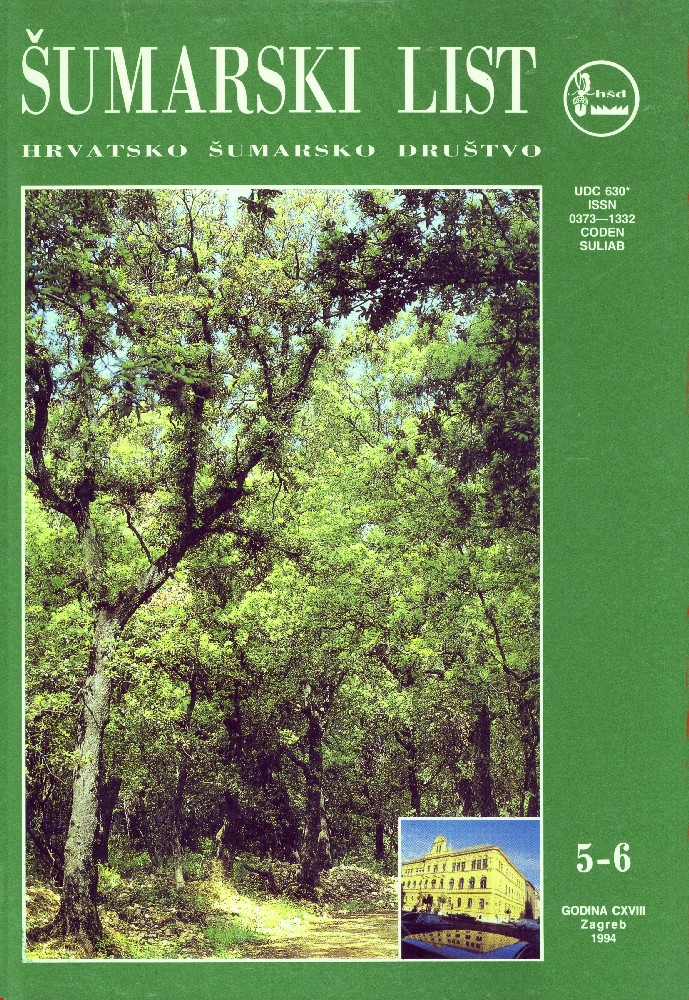
broj: 5-6/1994
pdf (13,3 MB) |
|
||||||||||||||
| IZVORNI ZNANSTVENI ČLANCI | ||
| Orlić, S., Ocvirek, M. | UDK 630* 232.001/2 (Pseudotsuga menziesii (Mirb.) Franco) | |
| Research in Provenanses of Douglas Fir (Pseudotsuga menziesii (Mirb.) Franco) in Croatia pdf HR EN | 139 | |
| Komlenović, N., Krstinić, A. | UDK 630* 161.6 (Populus sec. Aigeiros and Tacamahaca) | |
| Some physiological Characteristic of Croatia Polar Clons of Sections Aigeiros and Tacamahaca pdf HR EN | 147 | |
| Španjol, Ž. i Wolf, S. | UDK 630* + 712 | |
| Biological-Environmental and Space Valorization Park-Forest »Komrčar« on the Island of Rab pdf HR EN | 153 | |
| Summary: Once a deserted pasture, the Komrčar forest on the island of Rab started to be afforested in 1890 thanks to the Rab chief forester Pravdoje Belia. By the bill of Law issued on March 15. 1965, the Institute of environmental protection in Zagreb registered the forest in the Records of protected nature areas under number 187 and in the category of nature reserves. According to the current Law of nature protection (TV. N. No. 3011994), the forest is today listed in the category of park forests. In spite of the neglected vegetation in some places and the necessity of sanctions in the devastated parts, today´s status of the park is such that landscape architectural work would be desirable in order to exploit the great potentials of the park. The authors did a detailed research in 1992 and 1993. It first encompassed the greater area which, besides the 8.3 ha Komrčar forest, also included the adjoining nature areas along the promenade Fra Odorik Badurina up to the 0.6 ha large Trg Slobode square. There is also the terraced 1.9 ha surface below the town cemetery and the 0.5 ha graveyard itself. Each part was dendrologically completely investigated, i.e. all tree species were recorded. The paper presents the standpoint in the from of the guidelines for revitalization, improvement and proposed amanagement of each of the areas separately, regarding the whole nature area as a unique biological and environmental landscape. The Komrčar park forest itself is divided into three zones as to he space, function and biological I environmental diversity—protecional zone, park forest zone and park zone. This division enables creative operations in all three zones, particularly I and II. Besides improvements of the devastated areas, landscape-architectural work would entail a number of small jobs in the park composition, supplementing certain areas with new elements such as trees, brushes, flowers, paths, benches, tables, information panels,fountains, sculptures, etc. The revitalization of the Komrčar forest park should take into consideration both the present status and the future demands and possibilities. New contents and the suggested categories will provide sufficient reasons for the »look inside«, whereby the number of visitors, particularly tourists, will increase. Proper improvement and maintenance programme of the forest park will enable the spatial and biological valorization. In practice, the programme will equally respect all the components: — natural appearance — culture and history — environment — style — aesthetics — biology and ecology — tourism and management Among the basic issues to be solved in the course of park´s renovation is the choice of vegetation, which is the significant feature of any open space. Preference should be given to the autochtonous plants, i.e. the Mediterranean tree species, brushwood and undergrowth. A jewel in the stone ring of the old Rab, Komrčar deserves all expert work it can get. Its significance in terms of biology, and recreation is inco,parable. Though small in area, the forest park is heterogeneous as to the relief, ecology and vegetation. Therefore the work should be directed to its zonation. Considering the size of the area, every operation should be planned and carried out at the smallest possible scale. Each tall tree, bush or a group of trees present a whole in terms of biology, ecology and landscape value. This concept should also be the guideline in creating the management programme of the forest park.$ Key words: park-forest Komrčar; historical presentation; dendrology; biological!environmental valorization; space valorization; management; zonation | ||
| Huber, D., Radišić, B., Novosel, D., Frković, A. | UDK 591.5 (497.13) (Canis lupus) | |
| Survey of Public Atitude Twords Wolves in Croatia pdf HR EN | 167 | |
| STRUČNI ČLANCI | ||
| Tomašević, A. | UDK 630* 232.216 | |
| Undermining as First Stage of Soil Preparation for Afforestation pdf HR EN | 173 | |


